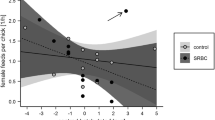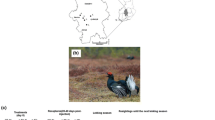Abstract
Immunocompetence may be especially important in long-lived species where infectious organisms may have detrimental effects upon future reproductive value of hosts. The resource demand for immunocompetence may reduce resource availability for reproduction and a trade-off between these traits has therefore been proposed. Capital breeders, such as the common eider (Somateria mollissima), rely upon accumulated body reserves during reproduction. Eiders lose more than 40% of pre-breeding body mass during egglaying and incubation and many females abandon their ducklings to other females after hatching. Results from our observational study show that levels of leukocytes (i.e., lymphocytes, heterophils and heterophil/lymphocyte ratio) are not related to body mass early in the incubation period. However, eider females with low initial body mass showed signs of immunosuppression (i.e., decreased late levels of lymphocytes) and increased response towards stressors (i.e., increased heterophil/lymphocyte ratio) later in the incubation period. Moreover, females with low lymphocyte levels more frequently abandoned their brood, and females abandoning young had an increased return rate to the next breeding season. However, among brood abandoning females return rate was lower for the females with low lymphocyte levels. These results suggest that immunosuppression, as indicated by low lymphocyte levels, is a reproductive cost that may be partly compensated for by abandoning young.





Similar content being viewed by others
References
Baillie SR, Milne H (1989) Movements of Eiders Somateria mollissima on the east coast of Britain. Ibis 131:321–335
Bustnes JO, Erikstad KE (1991) Parental care in the common eider (Somateria mollissima): factors affecting abandonment and adoption of young. Can J Zool 69:1538–1545
Bustnes JO, Erikstad KE (1993) Site-fidelity in the common eider Somateria mollissima females. Orn Fenn 70:11–16
Bustnes JO, Erikstad KE (1995) Brood abandonment in common eiders: a reply to H. Pöysä. Can J Zool 73:1577–1578
Bustnes JO, Tertitsky GM (2000) The common eider. In: Anker-Nilssen T, Bakken V, Strøm H, Golovkin AN, Bianki VV, Tatarinkova IP (eds) The status of marine birds breeding in the Barents sea region. Norsk Polarinstitutt Rapportserie 113. Norsk Polarinstitutt, Tromsø, pp 46–47
Bustnes JO, Erikstad KE, Bjørn TH (2002) Body condition and brood abandonment in common eiders breeding in the High Arctic. Waterbirds 25:63–66
Christe P, Møller AP, de Lope F (1998) Immuno-competence and nestling survival in the house martin: "the tasty chick hypothesis". Oikos 83:175–179
Daan S, Deerenberg C, Dijkstra C (1996) Increased daily work precipitates natural death in the kestrel. J Anim Ecol 65:539–544
Dein J (1986) Hematology. In: Harrison GJ, Harrison WR (eds) Clinical avian medicine. Saunders, London, pp 178–191
Dufva R, Allander K (1995) Intraspecific variation in plumage colouration reflects immune response in great tits (Parus major). Funct Ecol 9:786–789
Erikstad KE, Bustnes JO, Moum T (1993) Clutch-size determination in precocial birds: a study of the common eider. Auk 110:623–628
Fitzgerald L (1988) Exercise and the immune system. Immun Today 9:337–339
Folstad I, Karter AJ (1992) Parasites, bright males and the immunocompetence handicap. Am Nat 139:603–622
Folstad I, Skarstein F (1997) Is male germ line control creating avenues for female choice? Behav Ecol 8:109–112
Freckleton RP (2002) On the misuse of residuals in ecology: regression of residuals vs. multiple regression. J Anim Ecol 71:542–545
García-Berthou E (2001) On the misuse of residuals in ecology: testing regression residuals vs. the analysis of covariance. J Anim Ecol 70:708–711
Gorman ML, Milne H (1972) Crèche behaviour in the common eider Somateria m. mollissima L. Ornis Scand 3:21–26
Green AJ (2001) Mass/length residuals: measures of body condition or generators of spurious results? Ecology 82:1473–1483
Gross WB, Siegel HS (1983) Evaluation of the heterophil/lymphocyte ratio as a measure of stress in chickens. Avian Dis 27:972–979
Gustafsson L, Nordling D, Andersson MS, Sheldon BC, Quarnstrøm A (1994) Infectious-diseases, reproductive effort and the cost of reproduction in birds. Philos Trans R Soc Lond B 346:323–331
Hanssen SA, Erikstad KE, Johnsen V, Bustnes JO (2003a) Differential investment and costs during avian incubation determined by individual quality: an experimental study of the common eider Somateria mollissima. Proc R Soc Lond B 270:531–537
Hanssen SA, Folstad I, Erikstad KE, Oksanen A (2003b) Costs of parasites in common eiders: effects of antiparasite treatment. Oikos 100:105–111
Janeway CA, Travers P, Walport M, Capra JD (1999) Immunobiology: The immune system in health and disease, 4th edn. Taylor and Francis, London
Kehoe FP (1989) The adaptive significance of crèching behaviour in the white-winged scoter (Melanitta fusca deglandi). Can J Zool 67:406–411
Lazarus J, Inglis IR (1978) The breeding behaviour of the Pink-footed Goose: parental care and vigilant behaviour during the fledging period. Behaviour 65:62–88
Lazarus J, Inglis IR (1986) Shared and unshared parental investment, parent-offspring conflict and brood size. Anim Behav 34:1791–1804
Lessells CM, Boag PT (1987) Unrepeatable repeatabilities: a common mistake. Auk 104:116–121
Lochmiller RL, Deerenberg C (2000) Trade-offs in evolutionary immunology: just what is the cost of immunity? Oikos 88:87–98
Maxwell MH (1993) Avian blood leucocyte responses to stress. World Poult Sci J 49:34–43
Munro J, Bédard J (1977) Crèche formation in the common eider. Auk 94:759–771
Norris K, Evans MR (2000) Ecological immunology: life history trade-offs and immune defence in birds. Behav Ecol 11:19–26
Ots I, Murumagi A, Horak P (1998) Haematological health state indices of reproducing Great Tits: methodology and sources of natural variation. Funct Ecol 12:700–707
Parker H, Holm H (1990) Patterns of nutrient and energy expenditure in female common eiders nesting in the high Arctic. Auk 107:660–668
Parslow TG (1994) The phagocytes: neutrophiles and macrophages. In: Stites DP, Terr AI, Parslow TG (eds) Basic and clinical immunology, 8th edn. Appleton and Lange, Norwalk, Conn., pp 9–20
Price PW (1980) Evolutionary biology of parasites. Princeton University Press, N.J.
Roff DA (1992) The evolution of life histories. Chapman and Hall, New York
Roitt I, Brostoff J, Male D (1998) Immunology, 5th edn. Mosby, London
Rothman KJ (1990) No adjustments are needed for multiple comparisons. Epidemiology 1:43–46
Saino N, Bolzern AM, Møller AP (1997) Immunocompetence, ornamentation, and viability of male barn swallows (Hirundo rustica). Proc Natl Acad Sci USA 94:549–552
Saino N, Calza S, Ninni P, Møller AP (1999) Barn swallows trade survival against offspring condition and immunocompetence. J Anim Ecol 68:999–1009
Sapolsky RM (1992) Neuroendocrinology of the stress response. In: Becker JB, Breedlove SM, Crews D (eds) Behavioural endocrinology. MIT Press, Cambridge, Mass., pp 287–384
SAS (1999) SAS OnlineDoc, version 8. SAS Institute, Cary, N.C.
Schanz T von, Bensch S, Grahn M, Hasselquist D, Wittzell H (1999) Good genes, oxidative stress and condition-dependent signals. Proc R Soc Lond B 266:1–12
Sheldon BC, Verhulst S (1996) Ecological immunology: costly parasite defences and trade-offs in evolutionary ecology. Trends Ecol Evol 11:317–321
Siegel HS (1985) Immunological responses as indicators of stress. World Poult Sci J 41:36–44
Skarstein F, Folstad I (1996) Sexual dichromatism and the immunocompetence handicap: an observational approach using Arctic charr. Oikos 76:359–367
Stearns SC (1992) The evolution of life histories. Oxford University Press, Oxford
Swennen C (1990) Dispersal and migratory movements of Eiders Somateria mollissima breeding in The Netherlands. Ornis Scand 21:17–27
Wakeley JS, Mendall HL (1976) Migrational homing and survival of adult female Eiders in Maine. J Wildl Manage 40:15–21
Warelius KH (1993) The effect of intestinal helminths of body condition of prelaying eiders Somateria m. mollissima (L.). Cand Sci thesis, University of Tromsø, Norway
Watson MD, Robertson GJ, Cooke F (1993) Egg laying time and laying interval in the common eider. Condor 95:869–878
Williams GC (1966) Natural selection, the cost of reproduction, and a refinement of Lack's principle. Am Nat 100:687–690
Yoccoz NG, Erikstad KE, Bustnes JO, Hanssen SA, Tveraa T (2002) Costs of reproduction in common eiders (Somateria mollissima): an assessment of relationships between reproductive effort and future survival and reproduction based on observational and experimental studies. J Appl Stat 29:57–64
Acknowledgements
We acknowledge V. Johnsen, H. Sandvik, T. Sigurdsen and T. Johnsen for assistance in the field and E. Andersen for performing the blood cell counts. S. Liljedal, G. Rudolfsen and F. Skarstein kindly commented on earlier drafts of the MS. The study was financed through grants from the Norwegian Research Council and the Directorate for Nature Management.
Author information
Authors and Affiliations
Corresponding author
Rights and permissions
About this article
Cite this article
Hanssen, S.A., Folstad, I. & Erikstad, K.E. Reduced immunocompetence and cost of reproduction in common eiders. Oecologia 136, 457–464 (2003). https://doi.org/10.1007/s00442-003-1282-8
Received:
Accepted:
Published:
Issue Date:
DOI: https://doi.org/10.1007/s00442-003-1282-8




